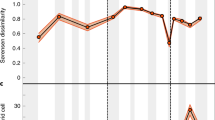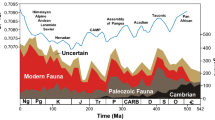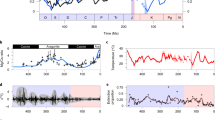Abstract
Throughout the Phanerozoic eon (∼542 Myr ago to the present), the diversity of marine organisms has varied. These changes are fairly well resolved1, but the controls on origination and diversification are less well understood. Changes in origination rates are thought to arise from a complex interplay between biological forces such as competition and predation2, phytoplankton stoichiometry3 and bioturbation3 and abiotic controls such as environmental setting4, temperature5,6, sea level7 and nutrient availability8. Here we statistically assess relationships between records of environmental conditions9,10,11,12,13,14 and global marine origination rates2 during the Phanerozoic. We find significant positive correlations between changes in origination rates and variations in indicators of continental weathering (87Sr/86Sr) and phosphorus recycling (δ34S), as well as a significant negative correlation between variability in origination rates and eustatic sea level. We suggest that continental weathering, phosphorus recycling and sea level—through the exposure of the continental shelf area to erosion—are all controls on the availability of marine nutrients. We therefore propose that over secular timescales, nutrient availability, as controlled by continental weathering and phosphorus recycling, is an important regulator of genus-level origination in the marine realm, with periods of increased nutrient availability associated with higher origination rates.
This is a preview of subscription content, access via your institution
Access options
Subscribe to this journal
Receive 12 print issues and online access
$259.00 per year
only $21.58 per issue
Buy this article
- Purchase on Springer Link
- Instant access to full article PDF
Prices may be subject to local taxes which are calculated during checkout


Similar content being viewed by others
References
Alroy, J. et al. Phanerozoic trends in the global diversity of marine invertebrates. Science 321, 97–100 (2008).
Alroy, J. Dynamics of origination and extinction in the marine fossil record. Proc. Natl Acad. Sci. USA 105, 11536–11542 (2008).
Martin, R. E., Quigg, A. & Podkovyrov, V. Marine biodiversification in response to evolving phytoplankton stoichiometry. Palaeogeogr. Palaeoclimatol. Palaeoecol. 258, 277–291 (2008).
Kiessling, W., Simpson, C. & Foote, M. Reefs as cradles of evolution and sources of biodiversity in the Phanerozoic. Science 327, 196–198 (2010).
Valentine, J. W. Climatic regulation of species diversification and extinction. Geol. Soc. Am. Bull. 79, 273–276 (1968).
Mayhew, P. J., Jenkins, G. B. & Benton, T. G. A long-term association between global temperature and biodiversity, origination and extinction in the fossil record. Proc. R. Soc. B 275, 47–53 (2008).
Erwin, D. H. Early introduction of major morphological innovations. Acta Palaeontol. Pol. 38, 281–294 (1994).
Martin, R. E. Secular increase nutrient levels through the Phanerozoic: Implications for productivity, biomass, and diversity of the marine biosphere. Palaios 11, 209–219 (1996).
Veizer, J. et al. 87Sr/86Sr, δ13C and δ18O evolution of Phanerozoic seawater. Chem. Geol. 161, 59–88 (1999).
McArthur, J. M., Howarth, R. J. & Bailey, T. R. Strontium isotope stratigraphy: LOWESS version 3: Best fit to the marine Sr-isotope curve for 0-509 Ma and accompanying look-up table for deriving numerical age. J. Geol. 109, 155–170 (2001).
Kampschulte, A. & Strauss, H. The sulfur isotopic evolution of Phanerozoic seawater based on the analysis of structurally substituted sulfate in carbonates. Chem. Geol. 204, 255–286 (2004).
Haq, B. U. & Schutter, S. R. A chronology of Paleozoic sea-level changes. Science 322, 64–68 (2008).
Haq, B. U., Hardenbol, J. & Vail, P. R. Chronology of fluctuating sea levels since the Triassic. Science 235, 1156–1167 (1987).
Miller, K. G. et al. The Phanerozoic record of global sea-level change. Science 310, 1293–1298 (2005).
Benton, M. J. The Red Queen and the Court Jester: Species diversity and the role of biotic and abiotic factors through time. Science 323, 728–732 (2009).
Foote, M. & Raup, D. M. Fossil preservation and the stratigraphic ranges of taxa. Paleobiology 22, 121–140 (1996).
Shields, G. A. A normalized seawater strontium isotope curve: Possible implications for Neoproterozoic-Cambrian weathering rates and the further oxygenation of the Earth. Electron. Earth 2, 35–42 (2007).
Wheat, C. G., McManus, J., Mottl, M. J. & Giambalvo, E. Oceanic phosphorus imbalance: Magnitude of the mid-ocean ridge flank hydrothermal sink. Geophys. Res. Lett. 30, 1895 (2003).
Follmi, K. B. 160 m.y. record of sedimentary phosphorus burial: Coupling of climate and continental weathering under greenhouse and icehouse conditions. Geology 23, 859–862 (1995).
Van Cappellen, P. V. & Ingall, E. D. Redox stabilization of the atmosphere and oceans by phosphorus-limited marine productivity. Science 271, 493–496 (1996).
Wortmann, U. G. & Chernyavsky, B. M. Effect of evaporite deposition on early Cretaceous carbon and sulphur cycling. Nature 446, 654–656 (2007).
Arthur, M. A. & Sageman, B. B. Marine black shales: Depositional mechanisms ad environments of ancient deposits. Annu. Rev. Earth Planet. Sci. 22, 499–551 (1994).
Vermeij, G. J. Economics, volcanoes, and Phanerozoic revolutions. Paleobiology. 21, 125–152 (1995).
Allmon, W. D. in Evolutionary Paleoecology (eds Allmon, W. D. & Botjer, D. J.) 9–26 (Columbia Univ. Press, 2001).
Gradstein, F. M., Ogg, J. G. & Smith, A. G. A Geologic Time Scale 2004 (Cambridge Univ. Press, 2004).
Wei, W. & Peleo-Alampay, A. Updated Cenozoic nannofossil magnetobiochronology. INA Newslet. 15, 15–21 (1993).
Vermeij, G. in Evolution on Planet Earth: The Impact of the Physical Environment (eds Rothschild, L. J. & Lister, A. M.) 209–232 (Academic, 2003).
Sharp, Z. Stable Isotope Geochemistry (Pearson Prentice Hall, 2007).
Raymo, M. E. & Ruddiman, W. F. Tectonic forcing of late Cenozoic climate. Nature 359, 117–122 (1992).
Acknowledgements
We thank J. Alroy and K.G. Miller for sharing their databases on Phanerozoic marine origination rates and sea level, respectively. J.S. Crampton and G.S. Herbert provided insightful comments on an earlier draft. D.C. Roman and G. Fox as well as C.H. Cuartas gave helpful advice on the various statistical questions and on R programming, respectively. We are also very grateful to W. Kiessling and R.E. Martin for constructive comments, which helped improve the manuscript. This is Paleobiology Database publication no. 116.
Author information
Authors and Affiliations
Contributions
Both authors contributed to the research, data interpretation and manuscript preparation.
Corresponding authors
Ethics declarations
Competing interests
The authors declare no competing financial interests.
Supplementary information
Supplementary Information
Supplementary Information (PDF 560 kb)
Rights and permissions
About this article
Cite this article
Cárdenas, A., Harries, P. Effect of nutrient availability on marine origination rates throughout the Phanerozoic eon. Nature Geosci 3, 430–434 (2010). https://doi.org/10.1038/ngeo869
Received:
Accepted:
Published:
Issue Date:
DOI: https://doi.org/10.1038/ngeo869
This article is cited by
-
Combining palaeontological and neontological data shows a delayed diversification burst of carcharhiniform sharks likely mediated by environmental change
Scientific Reports (2022)
-
Terrestrial forcing of marine biodiversification
Scientific Reports (2022)
-
Timing and periodicity of Phanerozoic marine biodiversity and environmental change
Scientific Reports (2019)
-
Trophic and tectonic limits to the global increase of marine invertebrate diversity
Scientific Reports (2017)
-
Cyanobacterial symbionts diverged in the late Cretaceous towards lineage-specific nitrogen fixation factories in single-celled phytoplankton
Nature Communications (2016)



